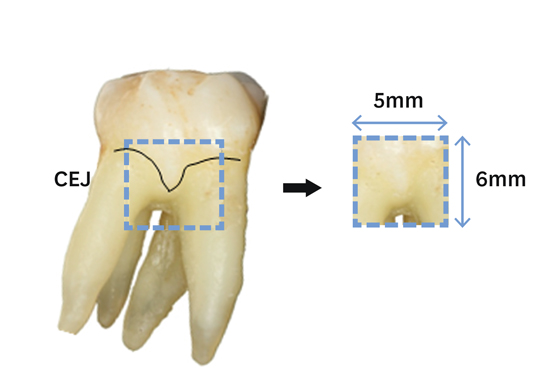1. Nishihara T, Koseki T. Microbial etiology of periodontitis. Periodontol 2000. 2004; 36:14–26.

2. Attar NB, Phadnaik MB. Bilateral cervicoenamel projection and its management: A case report with lingual involvement. J Indian Soc Periodontol. 2009; 13:168–171.

3. Askenas BG, Fry HR, Davis JW. Cervical enamel projection with gingival fenestration in a maxillary central incisor: report of a case. Quintessence Int. 1992; 23:103–107.
4. Masters DH, Hoskins SW Jr. Projection of cervical enamel into molar furcations. J Periodontol. 1964; 35:49–53.

5. Swan RH, Hurt WC. Cervical enamel projections as an etiologic factor in furcation involvement. J Am Dent Assoc. 1976; 93:342–345.

6. Atkinson SR. Changing dynamics of the growing face. Am J Orthod. 1949; 35:815–836.

7. Grewe JM, Meskin LH, Miller T. Cervical enamel projections: prevalence, location, and extent; with associated periodontal implications. J Periodontol. 1965; 36:460–465.

8. Blanchard SB, Derderian GM, Averitt TR, John V, Newell DH. Cervical enamel projections and associated pouch-like opening in mandibular furcations. J Periodontol. 2012; 83:198–203.

9. Carranza FA Jr, Jolkovsky DL. Current status of periodontal therapy for furcation involvements. Dent Clin North Am. 1991; 35:555–570.
10. Hou GL, Tsai CC. Relationship between periodontal furcation involvement and molar cervical enamel projections. J Periodontol. 1987; 58:715–721.

11. Hou GL, Tsai CC. Cervical enamel projection and intermediate bifurcational ridge correlated with molar furcation involvements. J Periodontol. 1997; 68:687–693.

12. Machtei EE, Wasenstein SM, Peretz B, Laufer D. The relationship between cervical enamel projection and class II furcation defects in humans. Quintessence Int. 1997; 28:315–320.
13. Bower RC. Furcation morphology relative to periodontal treatment. Furcation root surface anatomy. J Periodontol. 1979; 50:366–374.

14. Shiloah J, Kopczyk RA. Developmental variations of tooth morphology and periodontal disease. J Am Dent Assoc. 1979; 99:627–630.

15. Cho KY, Choi SM. Prevalence of cervical enamel projections and its relation to furcation involvement. J Korean Acad Periodontol. 1986; 16:96–97.
16. Moskow BS. Some observations on radicular enamel. J Periodontol. 1971; 42:92–96.

17. Bissada NF, Abdelmalek RG. Incidence of cervical enamel projections and its relationship to furcation involvement in Egyptian skulls. J Periodontol. 1973; 44:583–585.

18. Bye FL, Ghilzan RS, Coffesse RG. Root surface roughness after the use of different modes of instrumentation. Int J Periodontics Restorative Dent. 1986; 6:36–47.
19. Rosenberg RM, Ash MM Jr. The effect of root roughness on plaque accumulation and gingival inflammation. J Periodontol. 1974; 45:146–150.

20. Khatiblou FA, Ghodssi A. Root surface smoothness or roughness in periodontal treatment. A clinical study. J Periodontol. 1983; 54:365–367.

21. Stende GW, Schaffer EM. A comparison of ultrasonic and hand scaling. J Periodontol. 1961; 32:312–314.

22. Kawashima H, Sato S, Kishida M, Ito K. A comparison of root surface instrumentation using two piezoelectric ultrasonic scalers and a hand scaler in vivo. J Periodontal Res. 2007; 42:90–95.

23. Kishida M, Sato S, Ito K. Comparison of the effects of various periodontal rotary instruments on surface characteristics of root surface. J Oral Sci. 2004; 46:1–8.

24. Heo SR, Kim SA, Seo SR, Kim HS. A study on the loss of tooth substance and surface changes following root planing. J Korean Acad Periodontol. 1998; 28:351–369.

25. Eick S, Bender P, Flury S, Lussi A, Sculean A. In vitro evaluation of surface roughness, adhesion of periodontal ligament fibroblasts, and Streptococcus gordonii following root instrumentation with Gracey curettes and subsequent polishing with diamond-coated curettes. Clin Oral Investig. 2013; 17:397–404.

26. Aspriello SD, Piemontese M, Levrini L, Sauro S. Ultramorphology of the root surface subsequent to hand-ultrasonic simultaneous instrumentation during non-surgical periodontal treatments: an in vitro study. J Appl Oral Sci. 2011; 19:74–81.

27. Bower RC. Furcation morphology relative to periodontal treatment. Furcation entrance architecture. J Periodontol. 1979; 50:23–27.












 PDF
PDF ePub
ePub Citation
Citation Print
Print








 XML Download
XML Download